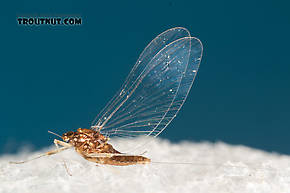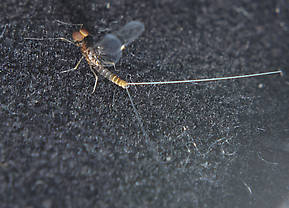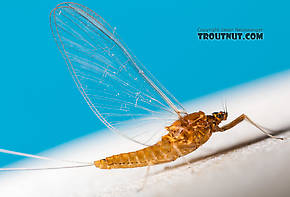Blog & Latest Updates
Fly Fishing Articles
Insects by Common Name


Mayfly Genus Acentrella (Tiny Blue-Winged Olives)
Taxonomic Navigation -?-
Kingdom
Animalia (Animals)
» Phylum
Arthropoda (Arthropods)
» Class
Insecta (Insects)
» Order
Ephemeroptera (Mayflies)
» Family
Baetidae (Blue-Winged Olives)
» Genus Acentrella (Tiny Blue-Winged Olives)
| Species in Acentrella | ||
| Acentrella insignificansTiny Blue-Winged Olive | 0 | 0 |
| Acentrella turbidaTiny Blue-Winged Olive | 0 | 0 |
6 species aren't included.
Common Names
| Match | Common Name |
| Tiny Blue-Winged Olives | |
| Miniature Blue-Winged Olives |
Hatching Behavior
The nymphs are normally excellent swimmers, but they become much less mobile as they're emerging and dead-drift (Dead-drift: The manner in which a fly drifts on the water when not moving by itself or by the influence of a line. Trout often prefer dead-drifting prey and imitating the dead-drift in tricky currents is a major challenge of fly fishing.) helplessly to the suface. Considering that they then emerge and fly away quickly, this makes the nymphs the prime stage to match during this emergence.
Spinner Behavior
Time Of Day: Dusk
These species molt into spinners and mate the same day they emerge. The spinner activity usually comes at dusk, or even after dark.Nymph Biology
Current Speed: Slow to Medium
Substrate: Rocks, logs, gravel, vegetation
Environmental Tolerance: Widely tolerant, but best in cold rivers
Pictures of 7 Mayfly Specimens in the Genus Acentrella:
Female Acentrella turbida (Tiny Blue-Winged Olive) Mayfly Spinner View 12 Pictures
View 12 Pictures
 View 12 Pictures
View 12 PicturesCollected July 17, 2017 from the Middle Fork Snoqualmie River in Washington
Added to Troutnut.com by Troutnut on July 24, 2017
Added to Troutnut.com by Troutnut on July 24, 2017
Male Acentrella turbida (Tiny Blue-Winged Olive) Mayfly Spinner View 3 PicturesI would not like to have to match this hatch. These are the smallest mayflies I have ever seen. I used to think Caenis was the smallest adult mayfly in the west but these guys are about 4mm long. The male eyes are two toned, brown above and olive below. The abdomen is dark brown interspersed with light brown. The abdomen is clear for the anterior (Anterior: Toward the front of an organism's body. The phrase "anterior to" means "in front of.") 2/3rd and the remainder is white. The tails are twice as long as the insect. There is only one pair of wings.
View 3 PicturesI would not like to have to match this hatch. These are the smallest mayflies I have ever seen. I used to think Caenis was the smallest adult mayfly in the west but these guys are about 4mm long. The male eyes are two toned, brown above and olive below. The abdomen is dark brown interspersed with light brown. The abdomen is clear for the anterior (Anterior: Toward the front of an organism's body. The phrase "anterior to" means "in front of.") 2/3rd and the remainder is white. The tails are twice as long as the insect. There is only one pair of wings.
 View 3 PicturesI would not like to have to match this hatch. These are the smallest mayflies I have ever seen. I used to think Caenis was the smallest adult mayfly in the west but these guys are about 4mm long. The male eyes are two toned, brown above and olive below. The abdomen is dark brown interspersed with light brown. The abdomen is clear for the anterior (Anterior: Toward the front of an organism's body. The phrase "anterior to" means "in front of.") 2/3rd and the remainder is white. The tails are twice as long as the insect. There is only one pair of wings.
View 3 PicturesI would not like to have to match this hatch. These are the smallest mayflies I have ever seen. I used to think Caenis was the smallest adult mayfly in the west but these guys are about 4mm long. The male eyes are two toned, brown above and olive below. The abdomen is dark brown interspersed with light brown. The abdomen is clear for the anterior (Anterior: Toward the front of an organism's body. The phrase "anterior to" means "in front of.") 2/3rd and the remainder is white. The tails are twice as long as the insect. There is only one pair of wings.Collected July 27, 2011 from the Touchet River in Washington
Added to Troutnut.com by Bnewell on July 27, 2011
Added to Troutnut.com by Bnewell on July 27, 2011
Female Acentrella turbida (Tiny Blue-Winged Olive) Mayfly Spinner View 3 Pictures
View 3 Pictures
 View 3 Pictures
View 3 PicturesCollected July 17, 2017 from the Middle Fork Snoqualmie River in Washington
Added to Troutnut.com by Troutnut on July 24, 2017
Added to Troutnut.com by Troutnut on July 24, 2017
Recent Discussions of Acentrella
acentrella nymph 22 Replies »
Posted by Goose on Nov 3, 2006
Last reply on Sep 15, 2022 by Wiflyfisher
Hi Jason! Do you have a picture of the (acentrella-miniature BWO nymph) on the site? I've been fishing them and wanted a better idea of how they look.
Thanks,
Bruce
ReplyThanks,
Bruce
Your Thoughts On Acentrella:
Top 10 Fly Hatches
Top Gift Shop Designs
Eat mayflies.
Top Insect Specimens
Miscellaneous Sites
Troutnut.com is copyright © 2004-2024 Jason
Neuswanger (email Jason). See my FAQ for information about use of my images.
 privacy policy
privacy policy
